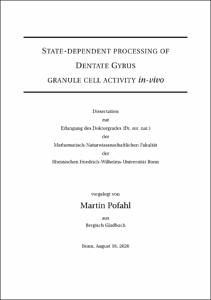Pofahl, Martin: State-dependent processing of Dentate Gyrus granule cell activity in-vivo. - Bonn, 2020. - Dissertation, Rheinische Friedrich-Wilhelms-Universität Bonn.
Online-Ausgabe in bonndoc: https://nbn-resolving.org/urn:nbn:de:hbz:5-60603
Online-Ausgabe in bonndoc: https://nbn-resolving.org/urn:nbn:de:hbz:5-60603
@phdthesis{handle:20.500.11811/8850,
urn: https://nbn-resolving.org/urn:nbn:de:hbz:5-60603,
author = {{Martin Pofahl}},
title = {State-dependent processing of Dentate Gyrus granule cell activity in-vivo},
school = {Rheinische Friedrich-Wilhelms-Universität Bonn},
year = 2020,
month = dec,
note = {The ability to form dissimilar neural activity patterns from similar sensory driven inputs is a phenomenon found in all vertebrates, called pattern separation. In mammals, pattern separation is closely related to a subregion of the hippocampus, namely the dentate gyrus. The dentate gyrus is an important relay conveying sensory information from the entorhinal cortex to the hippocampus proper and is characterized by a large number of rarely active granule cells that generate a very sparse neural code. While the coding features of granule cells during locomotion have been the subject of several studies, the dentate gyrus also shows activity patterns during immobility and sleep. However, the cellular composition of these patterns and their role in behavior remain elusive.
In this thesis we used dual color two photon-Ca2+-imaging in mice to visualize the activity of perforant path input fibers as well as the activity of individual dentate granule cells. We developed a novel approach of head fixation and cranial window design in order to gain visual access to the dentate gyrus. This enabled the recording of neural activity in head fixed mice running on a linear track. Using this approach we found sparse synchronized activity patterns that we termed network events. These network events emerged exclusively during immobility and were associated with distinct activations of the perforant path input. Interestingly, network events incorporate place and speed cells and their features are sensitive to changes in the environment. To compare the population coding during locomotion ant network activity we utilized principal component analysis in different behavioral states. Using this approach we could show that locomotion related population patterns are recapitulated during network events in immobile animals.},
url = {https://hdl.handle.net/20.500.11811/8850}
}
urn: https://nbn-resolving.org/urn:nbn:de:hbz:5-60603,
author = {{Martin Pofahl}},
title = {State-dependent processing of Dentate Gyrus granule cell activity in-vivo},
school = {Rheinische Friedrich-Wilhelms-Universität Bonn},
year = 2020,
month = dec,
note = {The ability to form dissimilar neural activity patterns from similar sensory driven inputs is a phenomenon found in all vertebrates, called pattern separation. In mammals, pattern separation is closely related to a subregion of the hippocampus, namely the dentate gyrus. The dentate gyrus is an important relay conveying sensory information from the entorhinal cortex to the hippocampus proper and is characterized by a large number of rarely active granule cells that generate a very sparse neural code. While the coding features of granule cells during locomotion have been the subject of several studies, the dentate gyrus also shows activity patterns during immobility and sleep. However, the cellular composition of these patterns and their role in behavior remain elusive.
In this thesis we used dual color two photon-Ca2+-imaging in mice to visualize the activity of perforant path input fibers as well as the activity of individual dentate granule cells. We developed a novel approach of head fixation and cranial window design in order to gain visual access to the dentate gyrus. This enabled the recording of neural activity in head fixed mice running on a linear track. Using this approach we found sparse synchronized activity patterns that we termed network events. These network events emerged exclusively during immobility and were associated with distinct activations of the perforant path input. Interestingly, network events incorporate place and speed cells and their features are sensitive to changes in the environment. To compare the population coding during locomotion ant network activity we utilized principal component analysis in different behavioral states. Using this approach we could show that locomotion related population patterns are recapitulated during network events in immobile animals.},
url = {https://hdl.handle.net/20.500.11811/8850}
}






